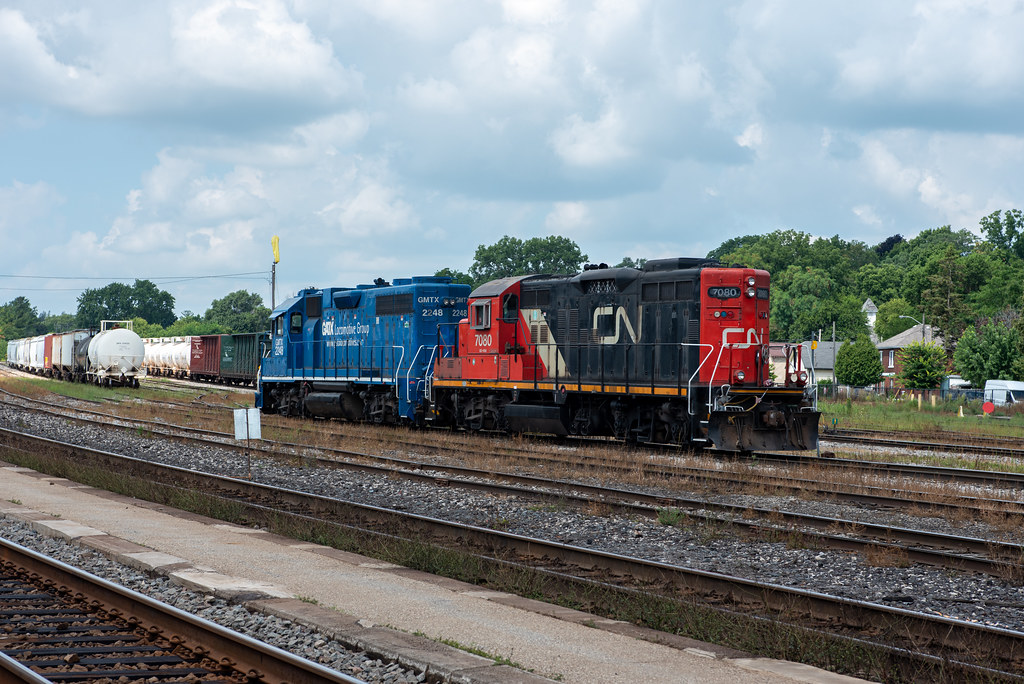The longest motive power for railway has been steam; since those early days, steam-powered locomotives carried people and freight worldwide. And sure, by the late 19th and early 20th Century, electricity became a popular choice for inter-urban railways. But on the mainlines, steam was king, and the last locomotives produced in the 20th Century could travel long distances and high speeds; I’m talking, of course, of the Northern’s, Pacific’s, and even larger engines. But these had one weakness, you needed a large crew to run them, two at the minimum, and they needed a lot of maintenance. Plus, they were loud, dirty, and took up a lot of space.

Graflex Crown Graphic – Nikon Nikkor-W 180mm 1:5.6 – Ilford HP5+ @ ASA-200 – Pyrocat-HD (1+1+100) 9:00 @ 20C
Canadian National began exploring the idea of a diesel-electric locomotive in 1924. These early locomotives were divided into three classes, road, switcher, and self-propelled. While many operators gladly accepted diesel switchers, the idea of a road locomotive or a self-propelled car seemed odd. Most self-propelled vehicles operated inter-urban or radial railways and were driven through electricity. Trying to test the value of these self-propelled rail diesel cars, Canadian National ran their test units from Montreal to Vancouver in 1925. Total travel time was sixty-seven hours with minimal delay. Realising the future of motive power had arrived, Canadian National’s first two diesel-electric locomotives, numbered 9000 and 9001, entered service in 1928. These were 1,330 horsepower V12 Beardmore units that couples operate in tandem or individually. They ran with a three-car set and later an eight-car group working mainly between Montreal and Kingston. But more were ordered and eventually were found across many low-traffic branch lines to serve commuter traffic. While the 1930s brought a great deal of streamlined diesel-electric locomotives, namely the iconic Electro-Movitive F-Units, the idea of producing a diesel-electric locomotive could serve both in road service and switching service became a goal of most locomotive makers. The American Locomotive Company (ALCO) created the first commercially viable road-switcher, the RS-1, in 1941. It proved the concept that a locomotive could serve in both roles. General Motors’ first attempt in 1947 with the EMD BL2 proved less successful, with only fifty-eight units produced. Taking the various mechanical and operational troubles back to the drawing board, in 1953 released, the GP7.

Nikon D750 – AF-S Nikkor 28-70mm 1:2.8D
Nikon D750 – AF-S Nikkor 28-70mm 1:2.8D
The locomotive’s EMD567b V16 engine outputted 1,500 horsepower, used a four-axel B-B wheel configuration and used a far better hood-style design with a high nose that offered a similar viewing angle to a traditional steam locomotive. While they could operate in tandem, General Motors produced a cabless version of the GP7b. The GP7 proved an instant success, and plants in La Grange, Illinois and London, Ontario, could barely keep up with the orders pouring in from around North America. Canadian National ordered twenty-five units, with the first locomotives rolling out of London in 1953. Among this first order is Locomotive 7558. What made 7558 unique was the lightweight flexicoil trucks and electro-dynamic braking system installed. While 7558 saw service across Canada, it felt most at home in the Prairies hauling long grain trains during harvest time in the late summer and early fall. This was all thanks to the braking system and flexicoil trucks. 7558 would go through a series of numbers before getting the 4803 and somehow keep its original green and yellow paint scheme. Its service on the mainlines ended in 1975 when the 4803 number was passed onto a new GP38-2W. But the GP7 remained a solid performer despite having successor locomotives in the line released; Canadian National reassigned the engine to switching duties at their Transcona Yards in Winnipeg, Manitoba. The engine has a chance to receive a new number and a modern paint scheme to the red-and-black with the white ‘worm’ CN logo.

Rolleiflex 2.8F – Carl Zeiss Planar 80mm 1:2.8 – Kodak Tri-X 400 (400TX) @ ASA-320 – Ilford Perceptol (1+1) 12:00
Nikon D750 – AF-S Nikkor 28-70mm 1:2.8D
After three decades of service, Ex-4803 saw retirement, not the scrapyard. Instead, Canadian National offered up the locomotive to the city of Toronto. It took the final journey from Winnipeg to Toronto. The original pre-1960 paint scheme was restored as one of the last locomotives through the Spadina Roundhouse. From there, it ended up in Storage in the John Street Roundhouse for several years before being displayed in 2010 at the Toronto Railway Museum. Today 4803 is a popular attraction at the museum as it retains the original high-noise configuration and green and yellow colour scheme.